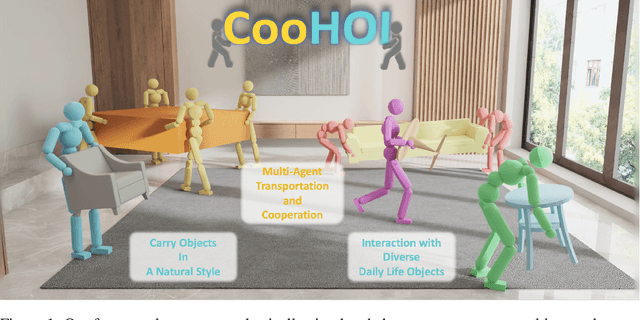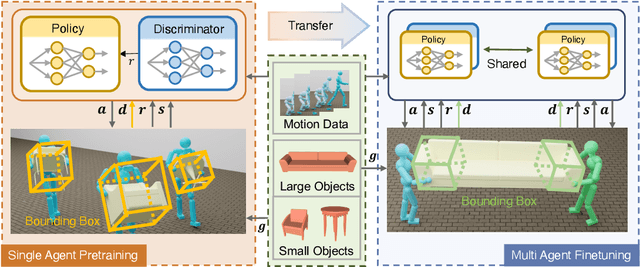Tai Wang
Strategic priorities for transformative progress in advancing biology with proteomics and artificial intelligence
Feb 21, 2025

Abstract:Artificial intelligence (AI) is transforming scientific research, including proteomics. Advances in mass spectrometry (MS)-based proteomics data quality, diversity, and scale, combined with groundbreaking AI techniques, are unlocking new challenges and opportunities in biological discovery. Here, we highlight key areas where AI is driving innovation, from data analysis to new biological insights. These include developing an AI-friendly ecosystem for proteomics data generation, sharing, and analysis; improving peptide and protein identification and quantification; characterizing protein-protein interactions and protein complexes; advancing spatial and perturbation proteomics; integrating multi-omics data; and ultimately enabling AI-empowered virtual cells.
Evolving Symbolic 3D Visual Grounder with Weakly Supervised Reflection
Feb 03, 2025Abstract:3D visual grounding (3DVG) is challenging because of the requirement of understanding on visual information, language and spatial relationships. While supervised approaches have achieved superior performance, they are constrained by the scarcity and high cost of 3D vision-language datasets. On the other hand, LLM/VLM based agents are proposed for 3DVG, eliminating the need for training data. However, these methods incur prohibitive time and token costs during inference. To address the challenges, we introduce a novel training-free symbolic framework for 3D visual grounding, namely Evolvable Symbolic Visual Grounder, that offers significantly reduced inference costs compared to previous agent-based methods while maintaining comparable performance. EaSe uses LLM generated codes to compute on spatial relationships. EaSe also implements an automatic pipeline to evaluate and optimize the quality of these codes and integrate VLMs to assist in the grounding process. Experimental results demonstrate that EaSe achieves 52.9% accuracy on Nr3D dataset and 49.2% Acc@0.25 on ScanRefer, which is top-tier among training-free methods. Moreover, it substantially reduces the inference time and cost, offering a balanced trade-off between performance and efficiency. Codes are available at https://github.com/OpenRobotLab/EaSe.
VLM-Grounder: A VLM Agent for Zero-Shot 3D Visual Grounding
Oct 17, 2024Abstract:3D visual grounding is crucial for robots, requiring integration of natural language and 3D scene understanding. Traditional methods depending on supervised learning with 3D point clouds are limited by scarce datasets. Recently zero-shot methods leveraging LLMs have been proposed to address the data issue. While effective, these methods only use object-centric information, limiting their ability to handle complex queries. In this work, we present VLM-Grounder, a novel framework using vision-language models (VLMs) for zero-shot 3D visual grounding based solely on 2D images. VLM-Grounder dynamically stitches image sequences, employs a grounding and feedback scheme to find the target object, and uses a multi-view ensemble projection to accurately estimate 3D bounding boxes. Experiments on ScanRefer and Nr3D datasets show VLM-Grounder outperforms previous zero-shot methods, achieving 51.6% Acc@0.25 on ScanRefer and 48.0% Acc on Nr3D, without relying on 3D geometry or object priors. Codes are available at https://github.com/OpenRobotLab/VLM-Grounder .
Omni6D: Large-Vocabulary 3D Object Dataset for Category-Level 6D Object Pose Estimation
Sep 26, 2024Abstract:6D object pose estimation aims at determining an object's translation, rotation, and scale, typically from a single RGBD image. Recent advancements have expanded this estimation from instance-level to category-level, allowing models to generalize across unseen instances within the same category. However, this generalization is limited by the narrow range of categories covered by existing datasets, such as NOCS, which also tend to overlook common real-world challenges like occlusion. To tackle these challenges, we introduce Omni6D, a comprehensive RGBD dataset featuring a wide range of categories and varied backgrounds, elevating the task to a more realistic context. 1) The dataset comprises an extensive spectrum of 166 categories, 4688 instances adjusted to the canonical pose, and over 0.8 million captures, significantly broadening the scope for evaluation. 2) We introduce a symmetry-aware metric and conduct systematic benchmarks of existing algorithms on Omni6D, offering a thorough exploration of new challenges and insights. 3) Additionally, we propose an effective fine-tuning approach that adapts models from previous datasets to our extensive vocabulary setting. We believe this initiative will pave the way for new insights and substantial progress in both the industrial and academic fields, pushing forward the boundaries of general 6D pose estimation.
LLaVA-3D: A Simple yet Effective Pathway to Empowering LMMs with 3D-awareness
Sep 26, 2024



Abstract:Recent advancements in Large Multimodal Models (LMMs) have greatly enhanced their proficiency in 2D visual understanding tasks, enabling them to effectively process and understand images and videos. However, the development of LMMs with 3D-awareness for 3D scene understanding has been hindered by the lack of large-scale 3D vision-language datasets and powerful 3D encoders. In this paper, we introduce a simple yet effective framework called LLaVA-3D. Leveraging the strong 2D understanding priors from LLaVA, our LLaVA-3D efficiently adapts LLaVA for 3D scene understanding without compromising 2D understanding capabilities. To achieve this, we employ a simple yet effective representation, 3D Patch, which connects 2D CLIP patch features with their corresponding positions in 3D space. By integrating the 3D Patches into 2D LMMs and employing joint 2D and 3D vision-language instruction tuning, we establish a unified architecture for both 2D image understanding and 3D scene understanding. Experimental results show that LLaVA-3D converges 3.5x faster than existing 3D LMMs when trained on 3D vision-language datasets. Moreover, LLaVA-3D not only achieves state-of-the-art performance across various 3D tasks but also maintains comparable 2D image understanding and vision-language conversation capabilities with LLaVA.
GRUtopia: Dream General Robots in a City at Scale
Jul 15, 2024Abstract:Recent works have been exploring the scaling laws in the field of Embodied AI. Given the prohibitive costs of collecting real-world data, we believe the Simulation-to-Real (Sim2Real) paradigm is a crucial step for scaling the learning of embodied models. This paper introduces project GRUtopia, the first simulated interactive 3D society designed for various robots. It features several advancements: (a) The scene dataset, GRScenes, includes 100k interactive, finely annotated scenes, which can be freely combined into city-scale environments. In contrast to previous works mainly focusing on home, GRScenes covers 89 diverse scene categories, bridging the gap of service-oriented environments where general robots would be initially deployed. (b) GRResidents, a Large Language Model (LLM) driven Non-Player Character (NPC) system that is responsible for social interaction, task generation, and task assignment, thus simulating social scenarios for embodied AI applications. (c) The benchmark, GRBench, supports various robots but focuses on legged robots as primary agents and poses moderately challenging tasks involving Object Loco-Navigation, Social Loco-Navigation, and Loco-Manipulation. We hope that this work can alleviate the scarcity of high-quality data in this field and provide a more comprehensive assessment of Embodied AI research. The project is available at https://github.com/OpenRobotLab/GRUtopia.
OVExp: Open Vocabulary Exploration for Object-Oriented Navigation
Jul 12, 2024



Abstract:Object-oriented embodied navigation aims to locate specific objects, defined by category or depicted in images. Existing methods often struggle to generalize to open vocabulary goals without extensive training data. While recent advances in Vision-Language Models (VLMs) offer a promising solution by extending object recognition beyond predefined categories, efficient goal-oriented exploration becomes more challenging in an open vocabulary setting. We introduce OVExp, a learning-based framework that integrates VLMs for Open-Vocabulary Exploration. OVExp constructs scene representations by encoding observations with VLMs and projecting them onto top-down maps for goal-conditioned exploration. Goals are encoded in the same VLM feature space, and a lightweight transformer-based decoder predicts target locations while maintaining versatile representation abilities. To address the impracticality of fusing dense pixel embeddings with full 3D scene reconstruction for training, we propose constructing maps using low-cost semantic categories and transforming them into CLIP's embedding space via the text encoder. The simple but effective design of OVExp significantly reduces computational costs and demonstrates strong generalization abilities to various navigation settings. Experiments on established benchmarks show OVExp outperforms previous zero-shot methods, can generalize to diverse scenes, and handle different goal modalities.
Empowering 3D Visual Grounding with Reasoning Capabilities
Jul 02, 2024Abstract:Although great progress has been made in 3D visual grounding, current models still rely on explicit textual descriptions for grounding and lack the ability to reason human intentions from implicit instructions. We propose a new task called 3D reasoning grounding and introduce a new benchmark ScanReason which provides over 10K question-answer-location pairs from five reasoning types that require the synerization of reasoning and grounding. We further design our approach, ReGround3D, composed of the visual-centric reasoning module empowered by Multi-modal Large Language Model (MLLM) and the 3D grounding module to obtain accurate object locations by looking back to the enhanced geometry and fine-grained details from the 3D scenes. A chain-of-grounding mechanism is proposed to further boost the performance with interleaved reasoning and grounding steps during inference. Extensive experiments on the proposed benchmark validate the effectiveness of our proposed approach.
CooHOI: Learning Cooperative Human-Object Interaction with Manipulated Object Dynamics
Jun 20, 2024



Abstract:Recent years have seen significant advancements in humanoid control, largely due to the availability of large-scale motion capture data and the application of reinforcement learning methodologies. However, many real-world tasks, such as moving large and heavy furniture, require multi-character collaboration. Given the scarcity of data on multi-character collaboration and the efficiency challenges associated with multi-agent learning, these tasks cannot be straightforwardly addressed using training paradigms designed for single-agent scenarios. In this paper, we introduce Cooperative Human-Object Interaction (CooHOI), a novel framework that addresses multi-character objects transporting through a two-phase learning paradigm: individual skill acquisition and subsequent transfer. Initially, a single agent learns to perform tasks using the Adversarial Motion Priors (AMP) framework. Following this, the agent learns to collaborate with others by considering the shared dynamics of the manipulated object during parallel training using Multi Agent Proximal Policy Optimization (MAPPO). When one agent interacts with the object, resulting in specific object dynamics changes, the other agents learn to respond appropriately, thereby achieving implicit communication and coordination between teammates. Unlike previous approaches that relied on tracking-based methods for multi-character HOI, CooHOI is inherently efficient, does not depend on motion capture data of multi-character interactions, and can be seamlessly extended to include more participants and a wide range of object types
MMScan: A Multi-Modal 3D Scene Dataset with Hierarchical Grounded Language Annotations
Jun 13, 2024



Abstract:With the emergence of LLMs and their integration with other data modalities, multi-modal 3D perception attracts more attention due to its connectivity to the physical world and makes rapid progress. However, limited by existing datasets, previous works mainly focus on understanding object properties or inter-object spatial relationships in a 3D scene. To tackle this problem, this paper builds the first largest ever multi-modal 3D scene dataset and benchmark with hierarchical grounded language annotations, MMScan. It is constructed based on a top-down logic, from region to object level, from a single target to inter-target relationships, covering holistic aspects of spatial and attribute understanding. The overall pipeline incorporates powerful VLMs via carefully designed prompts to initialize the annotations efficiently and further involve humans' correction in the loop to ensure the annotations are natural, correct, and comprehensive. Built upon existing 3D scanning data, the resulting multi-modal 3D dataset encompasses 1.4M meta-annotated captions on 109k objects and 7.7k regions as well as over 3.04M diverse samples for 3D visual grounding and question-answering benchmarks. We evaluate representative baselines on our benchmarks, analyze their capabilities in different aspects, and showcase the key problems to be addressed in the future. Furthermore, we use this high-quality dataset to train state-of-the-art 3D visual grounding and LLMs and obtain remarkable performance improvement both on existing benchmarks and in-the-wild evaluation. Codes, datasets, and benchmarks will be available at https://github.com/OpenRobotLab/EmbodiedScan.
 Add to Chrome
Add to Chrome Add to Firefox
Add to Firefox Add to Edge
Add to Edge